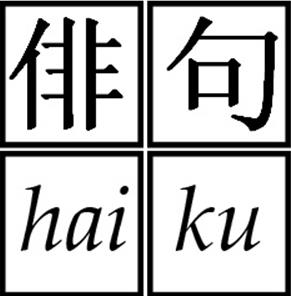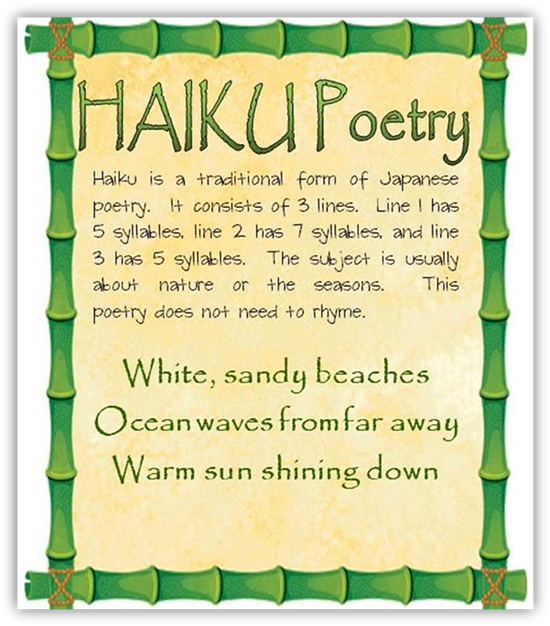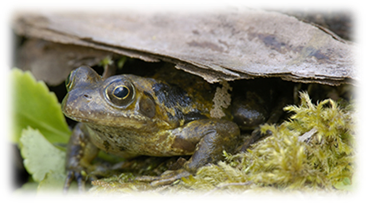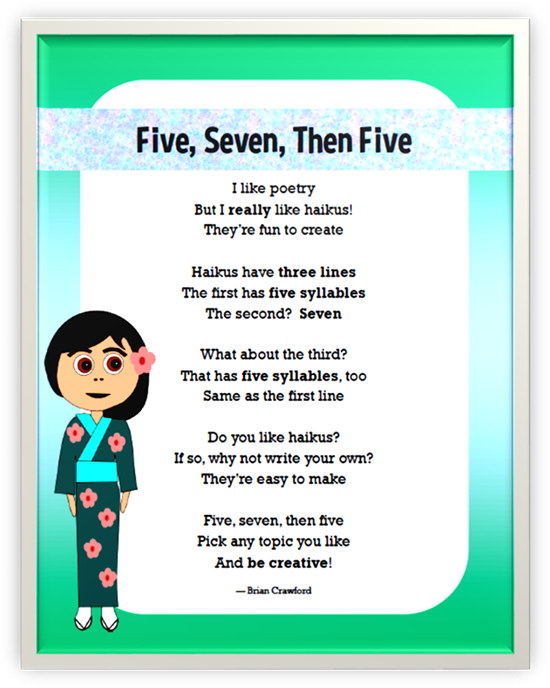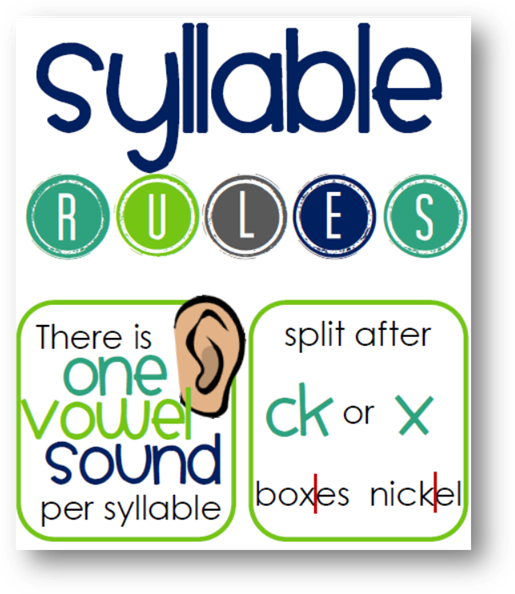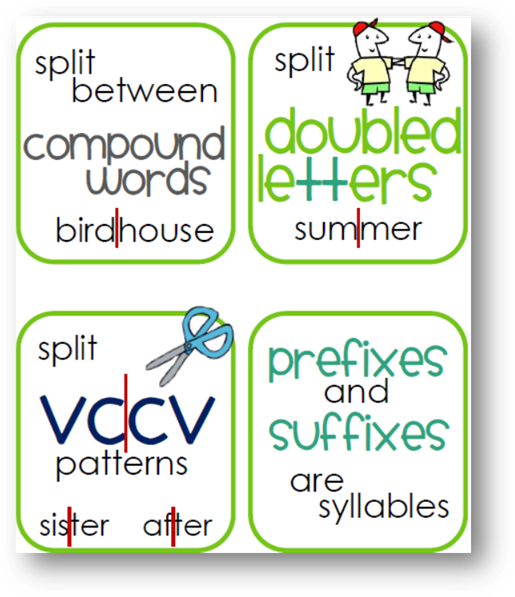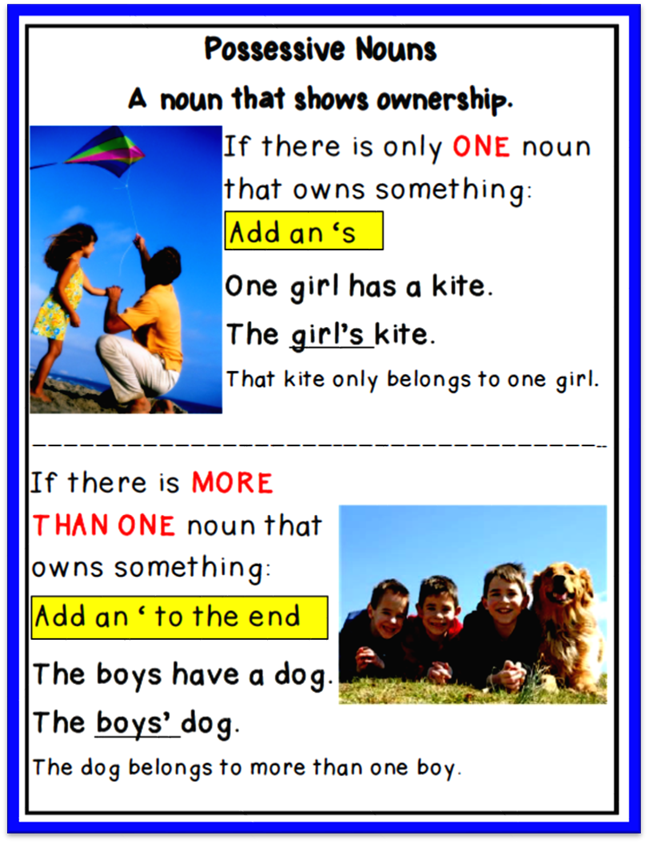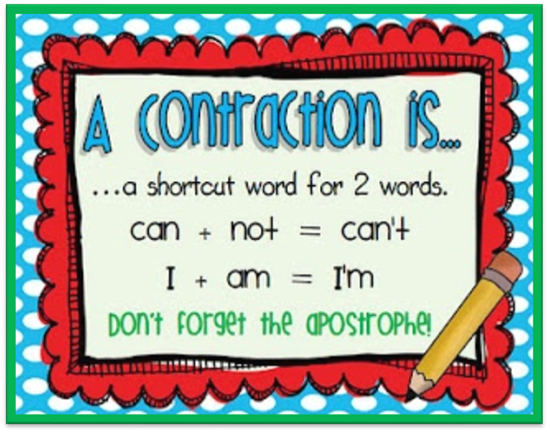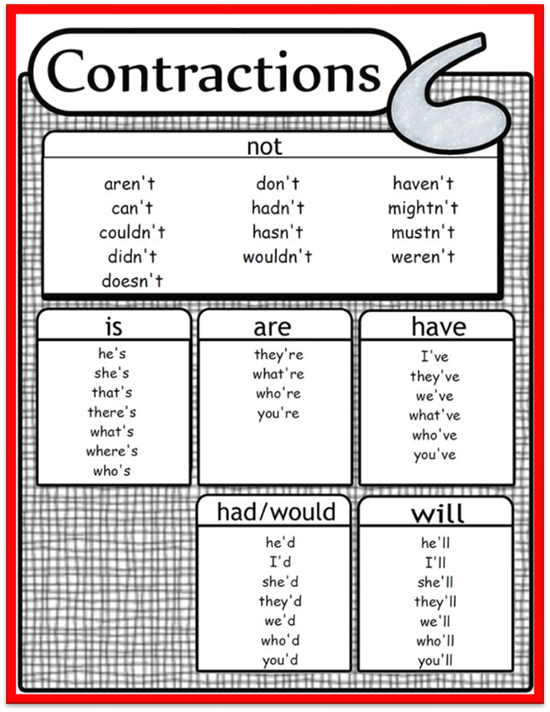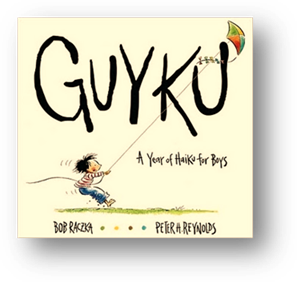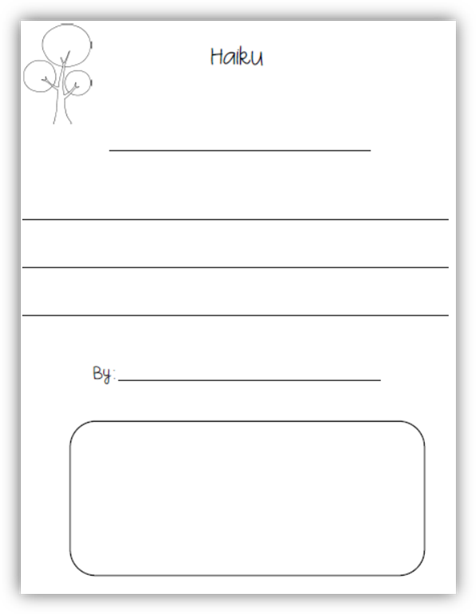Haiku Poetry
Unit Overview
|
Message to Adult
Mentor |
|
This lesson continues a format that is integrated and includes the
reading process (literary and informational), writing, spelling and fluency.
You will be asked to read aloud and model book handling, left-right reading,
expression and fluency. During Guided Oral
Reading, the student will read the story orally and work on reading strategies
and respond to literature. Spelling words will be introduced during this
lesson and a variety of spelling activities will be assigned. There will be
opportunities to make words with magnetic letters and learn word families.
Writing instruction will continue with a focus on writing sentences and
questions. Since daily writing is key to the reading-writing process, time
should be set aside daily for a journal entry. Topics for writing in the journal should be
self-selected and drawing a picture to accompany the writing is encouraged.
The writing journal will be turned in at the end of the course. |
Word Power
Sight Word
Scrabble
Fluency
|
Message to Adult Mentor: |
|
Let’s continue to increase sight word vocabulary. These
sentences include common words that appear often in text, which children need
to know instantly for their reading.
In the following sentences, the focus is on the words, which are high
frequency words (sight words). If you notice that the student is having
difficulty with these words, please practice them throughout the week.
|
Read the sentences silently, then aloud to your adult
mentor. It is important to be able to
recognize high frequency words and reading them should become automatic.
1.
I wish your work was over so you could play with us.
2.
Would you please write your name down right here?
3.
Do you wish you could fly?
4.
Do you know why I like your white dog?
5.
Both of us would like to make a wish or two.
6.
Why does he always write with a red pen?
7.
Your wish may work out very well.
8.
Any boy would like to ride in your green van.
9.
I learned about Thanksgiving.
10.
Do you feel better?
Sight
Word Building Fun
Sight Word -Word Search
 Now answer questions 1-10.
Now answer questions 1-10.
Spelling

|
Message to Adult
Mentor |
||||||||||
|
Please read the following to student: In this lesson,
you will learn to spell words with the digraph /ch/ spelling
patterns and academic vocabulary. With
your magnetic letters, make the following words, saying each word as you make
it.
Next, the student may choose one or more activities to practice their spelling words each day from the Spelling Menu below! |
Unit 26 Spelling Words
|
Unit 26
Spelling Words |
|
|
1.
chicken |
6.
cherries |
|
2.
chop |
7.
crunch |
|
3.
chair |
8.
cheese |
|
4.
church |
9.
bench |
|
5.
chick |
10.
peach |
Spelling Menu
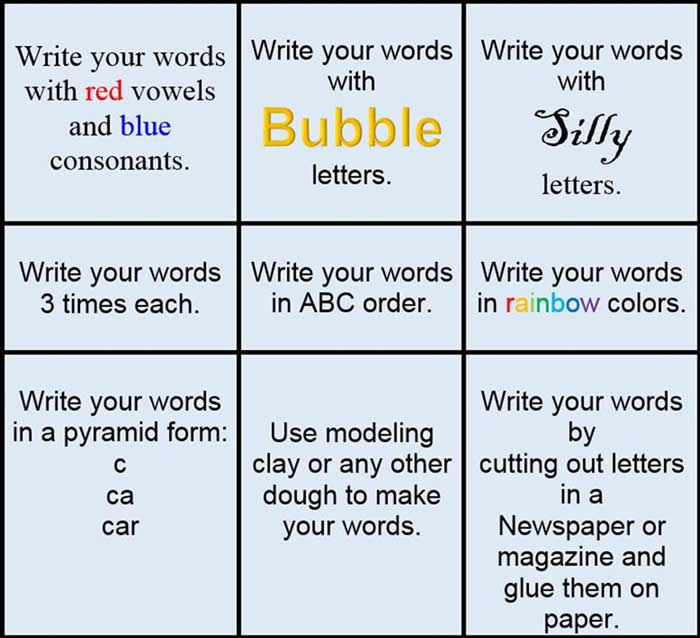
Click on SPELLING TRAINING to practice your spelling words. Add each of your spelling words to the list, then complete one the activites below the list.
Click on the link below to print a
fun activity to help you practice your spelling words!
 Now answer question 11.
Now answer question 11.
![]()
Reading 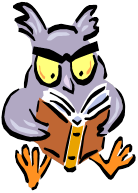
|
Message to Adult Mentor: |
|
Please read this paragraph to the student: It is time to turn
our attention to reading! Haiku is a
type of Japanese poetry. Haiku are short poems that usually describe nature
and a short moment in time; they often contains a reference to a season of
the year (called kigo). Haiku was
developed in Japan over 400 years ago. Haiku is now popular worldwide. Haiku often have a total of 17 syllables
and usually have three lines. The
first two lines of a Haiku are short opinions about the subject of the poem.
Then, in the final line, the view of the poem changes, a point is made, and
the heart is touched. |
Haiku Poetry
It is time to turn our attention to reading! Haiku is a type of Japanese poetry. Haiku are short poems that usually describe nature or feelings and a short moment in time; they often contains a reference to a season of the year (called kigo). Haiku was developed in Japan over 400 years ago. Haiku is now popular worldwide. Haiku often have a total of 17 syllables and usually have three lines. The first two lines of a Haiku are short opinions about the subject of the poem. Then, in the final line, the view poem changes, a point is made, and the heart is touched. Haiku are often filled with figurative language.
Examples of Haiku Poems:
|
|
This poem is a Haiku, a type of poetry that was first recognized in Japan many years ago. Can you explain how the first and the last lines of the poem are alike? If you said they both have five syllables, you are correct. How many syllables are in the second line? Right! There are seven!
This is how a Haiku is written. Let’s read another example!
|
|
How many syllables can you hear in each line? Discuss your answers with your mentor. Also, notice that there is not a title for the poems. Haiku poems are usually written without titles. Do you notice any examples of personification in this poem? (Remember: Personification means that the writer is showing animals, ideas, or objects as doing things that humans can do.) Correct! The mountains “asked me to climb” and “we sang” are both examples of personification in the poem because mountains are not actually alive and cannot talk. Why do you think the author would write this?
Syllables
A syllable is the sound of a vowel (A, E, I, O, U) that is created when pronouncing the letters A, E, I, O, U, or Y. The number of times that you hear the sound of a vowel is the number of syllables in a word.
Let’s practice by singing about Syllables to the tune of “Mary Had a Little Lamb.”
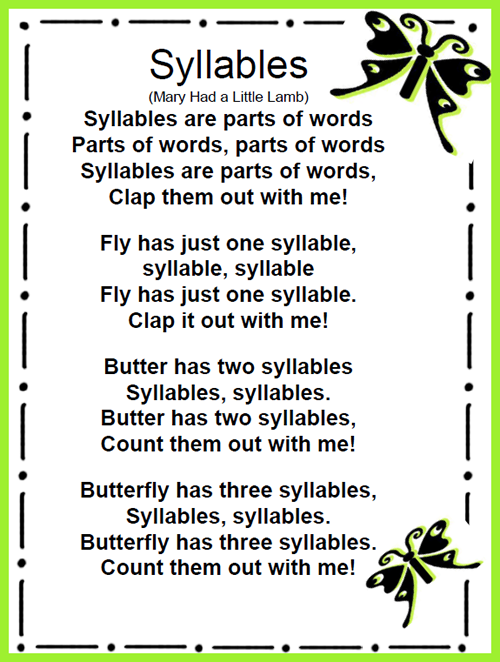
Click here to print the Chunking Cut and Paste Activity. Using newspapers, magazines, and other print materials, students scour the text looking for words that have the required syllables. When you find a word, cut out the whole word and cut it again to represent each syllable break. Using glue sticks, adhere the different word parts into the different columns and write out the whole word in the far right column.
 Now answer questions 12-15.
Now answer questions 12-15.

Writing - Grammar
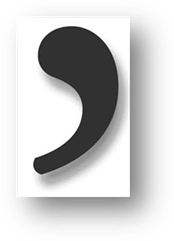
Contractions
vs. Possessives
|
Message
to Adult Mentor |
|
Read the following to the student and
discuss: A possessive word tells who or what
owns something. To make a word possessive, you add an apostrophe and
the letter s. Contractions are a shorter way of
saying what you need to day. Contractions are two words pushed
together to make one word. The first
word stays the same. The second word
pops out letters, and an apostrophe
holds their spot! The apostrophe goes
in the air. Don’t forget the apostrophe is key! |
A possessive word tells who or what owns something. To make a word possessive, you add an apostrophe and the letter s. While contractions are a shorter way of saying what you need to say. Contractions are two words “smashed” together to make one word. The first word stays the same. The second word pops out letters, and an apostrophe holds their spot! The apostrophe goes in the air. Don’t forget the apostrophe is key!
It is important to remember that possessive pronouns never use an apostrophe!
Examples: theirs, yours, ours, hers
Vs.
Hint:
If the word is a contraction you can replace the “smashed” word for the group of words and it will still make sense!
Let’s
try a few examples! Read each sentence
below. Find the word with the
apostrophe. Then choose whether the word is a contraction or possessive
noun. Discuss your answers with your
mentor.
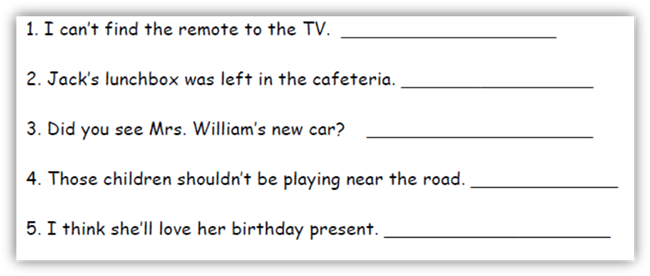
 Now
answer questions 16-30.
Now
answer questions 16-30.
Close Reading
“Guyku:
A Year of Haiku for Boys”
|
Message to Adult
Mentor |
|
Print Excerpts from “Guyku: A Year of Haiku for Boys” Read the following
to the student: You are now going to do a close reading of a Haiku poem from “Guyku: A Year of Haiku for Boys”. As you read, it is important that you underline with your pencil or use your highlighter to find important ideas as you read. After you have read the story, talk to your mentor about what you have highlighted. |
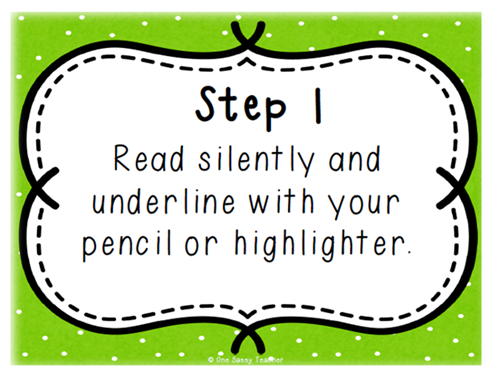
What do you think the poems are about? Record your thoughts on your Poetry Map.
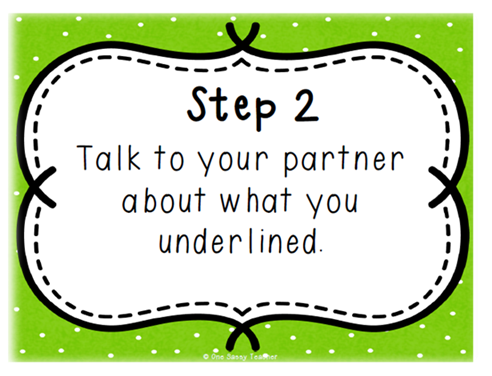
|
Message to Adult
Mentor |
|
Step 3: During the second reading of the story, you are going to read aloud. It is important that you read clearly and model left-right reading, expression and fluency. |
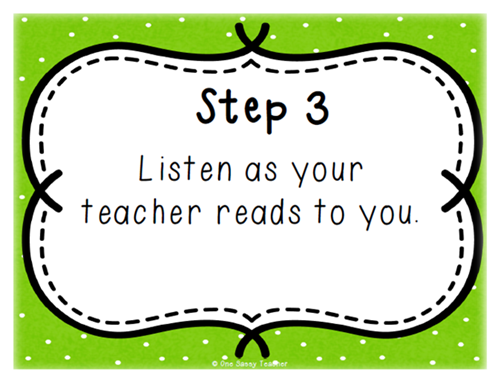
Do you want to change your mind about the meaning of the poems? If not, take a few minutes to write about the elements of poetry (rhyme, rhythm, simile, metaphor, personification, onomatopoeia) used in the poem on your Poetry Map.
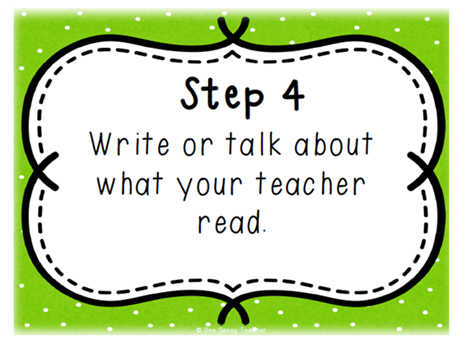
For the final reading, it is your turn to read aloud! You are going to read from the excerpts of “Guyku: A year of Haiku for Boys” aloud to your mentor. During the reading, it is important to remember what to do if you come to a word that is tricky for you. Remember to record any new thoughts that come to mind on your Poetry Map. What do you think is the theme or the message of these poems? How do you know? Explain.
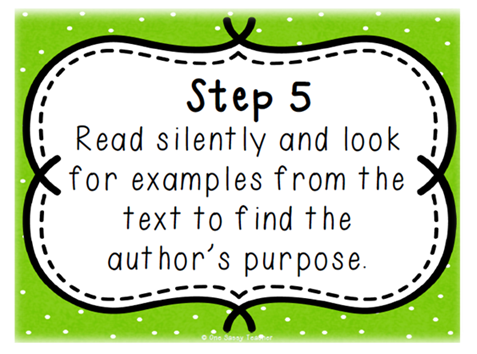
|
Message to Adult
Mentor |
|
As the student
reads, if the student comes to a word that they do not know, lead them
through the decoding strategies. You
may also encourage the student to pause and talk about parts of the
story. After the student is finished
reading, ask about the characters in the story and encourage the student to
orally retell what has happened. |
 Now answer questions 31-35.
Now answer questions 31-35.

Writing
Step 1: Choose Your Topic
Choose one of these ideas, or write your own:
Ø an animal communicating with you
Ø a loud storm beginning and ending
Ø ocean waves and sea creatures
Ø watching a sunset
Ø watching raindrops bounce off a leaf
Ø seeing smoke rise from a chimney on a cold winter day
Step 2: Think It Through
First, think of a topic about nature that interests you. Think about the things that you have seen
outside. Close your eyes and picture a
moment outside and everything around you.
Print the Graphic Organizer below to get you started.
Haiku Planning Page
Step 3: Write Your Poem
Use the ideas that you thought about on your planning sheet. Could you add any figurative language, such as personification, about the things you see and hear? You can use the bottom of the Haiku Planning Page to write your sloppy copy. Then, you may click on the picture below to print and use this template to write your final copy.
Step 4: Illustrate
Finally, draw and color a picture that shows the meaning of the poem! Be creative, colorful, and neat! When you are finished, place your Haiku Poem in your writing journal.
Now that you have practiced the process of writing a haiku poem. Choose at least two more topics to write haiku poems on. Your topics are endless!
You could create your own on construction or printer paper.
Once you have finished all (at least three) of your haiku poems, choose your favorite one and send it to you VLA Teacher on Friday.

Spelling
Test
|
Message to Adult
Mentor |
|||||||||||||||||||||||||||||||||
|
Please feel free
to use the sentences below or create your own! Read the following instruction to student: Now it is time to
take your spelling test. Number your writing paper to ten. Your adult mentor will read the screen and
say each spelling word as you write them. Then, read the sentence provided.
You will send your paper to the VLA Teacher to be checked. Please send it on Friday.
|
|||||||||||||||||||||||||||||||||
Now
it is time to take your spelling test! Number your writing paper to ten. Your adult mentor will read the screen and
say each spelling word as you write them. Then, read the sentence provided. You
will send your paper to the VLA Teacher to be checked. Please send it on Friday.
 Now answer question 36.
Now answer question 36.
Cursive Writing
Wouldn’t it be fun to give your chart a heading? And, wouldn’t it even be more fun to write
that heading in cursive? Give it a
try!
Now, it’s time to learn some new cursive letters and words.
Remember to practice on the extra lines on the worksheets. Let’s get moving. We have a lot to do…
We will start with the cursive letter “w.”
Look carefully at the following animated cursive “w.”
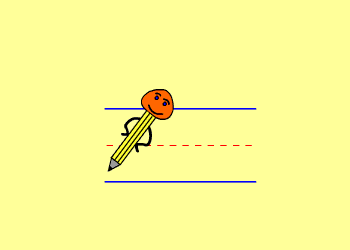
With your mentor’s help, read the chart below. It tells exactly how to form the cursive “w.”
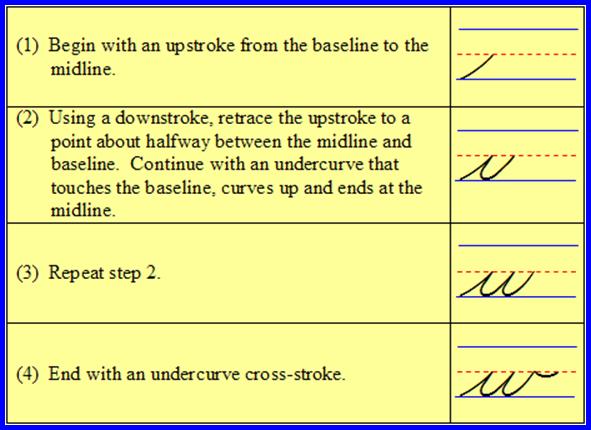
Next, look at the animated “w” again. As you look at it, trace the strokes in the
air. Do this 5 times, or more, if you
would like.

Next, practice writing the letter on paper. Click on this link to retrieve and print a
worksheet for practice. PDF File You will send this sheet to your VLA Teacher on Friday.
 Now answer question 37.
Now answer question 37.
Let’s move on to the cursive letter
“n.”
Look carefully at the following
animated cursive “n.”
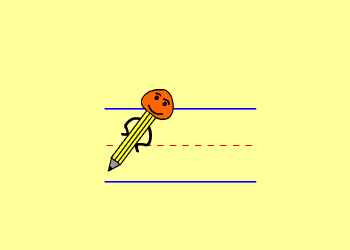
With your mentor’s help, read the chart below. It tells exactly how to form the cursive “n.”
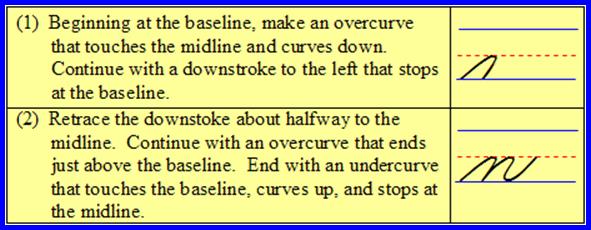
Next, look at the animated “n” again. As you look at it, trace the strokes in the
air. Do this 5 times, or more, if you
would like.

Next, practice writing the letter on paper. Click on this link to retrieve and print a
worksheet for practice. PDF File
You will send this sheet to your VLA Teacher on Friday.
 Now answer question 38.
Now answer question 38.
Let’s move on to the cursive letter
“m.”
Look carefully at the following
animated cursive “m.”
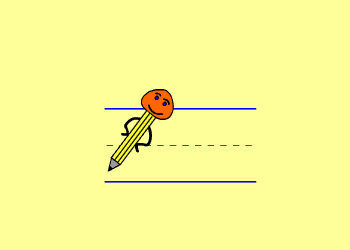
With your mentor’s help, read the chart below. It tells exactly how to form the cursive “m.”
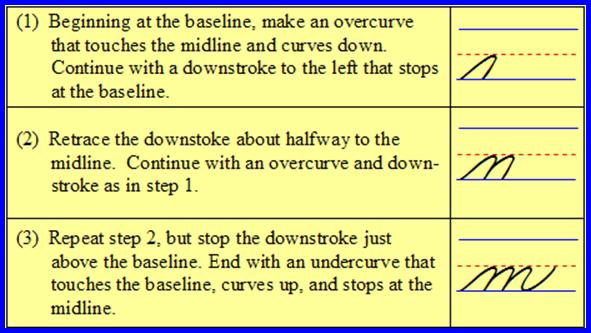
Next, look at the animated “m” again. As you look at it, trace the strokes in the
air. Do this 5 times, or more, if you
would like.

Next, practice writing the letter on paper. Click on this link to retrieve and print a
worksheet for practice. PDF File
You will send this sheet to your VLA Teacher on Friday.
 Now answer question 39.
Now answer question 39.
Let’s move on to the cursive letter
“x.”
Look carefully at the following animated cursive “x.”
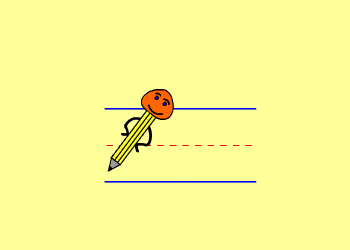
With your mentor’s help, read the chart below. It tells exactly how to form the cursive “x.”
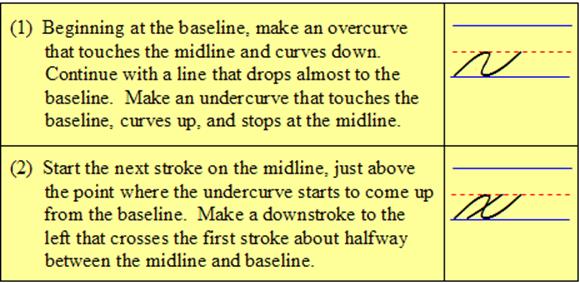
Next, look at the animated “x” again. As you look at it, trace the strokes in the
air. Do this 5 times, or more, if you
would like.

Next, practice writing the letter on paper. Click on this link to retrieve and print a
worksheet for practice. PDF File
You will send this sheet to your VLA Teacher on Friday.
 Now answer question 40.
Now answer question 40.
